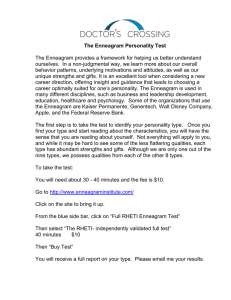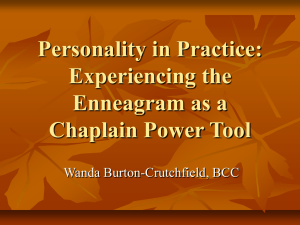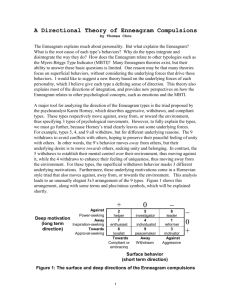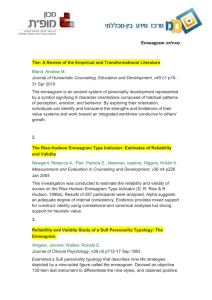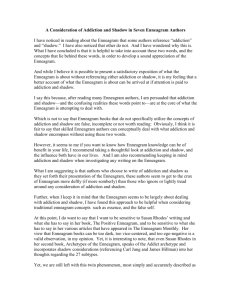The Enneagram - Simpson County Schools
advertisement
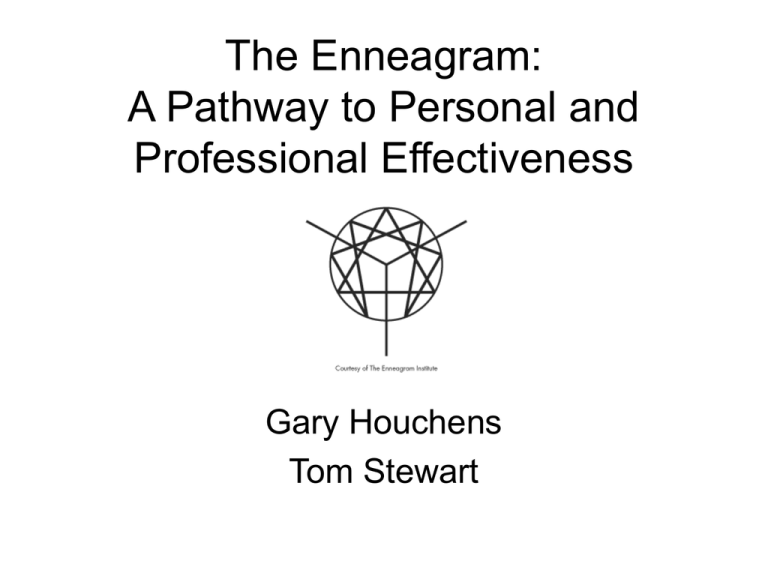
The Enneagram: A Pathway to Personal and Professional Effectiveness Gary Houchens Tom Stewart What is the Enneagram? • Personality-typing system that offers “profound insights into the nine very different ways in which people feel, think, and behave.” • Its roots appear to lie in Asia and the Middle East and date from several thousand years ago. Why the Enneagram? • Level of accuracy exceeds those of other personality-typing “tests.” • Comprehensive in its descriptions of each of its nine levels at healthy and at unhealthy levels. – Implies a certain level of self-study on the part of its “followers.” Why the Enneagram? • Additionally, “Although the Enneagram is not a religion, it has a spiritual as well as a psychological foundation. It parallels many aspects of Christian mysticism, the Kabbalah, and Sufism and attracts people of all religions. Most other personality systems, by contrast, have only a psychological basis.” Greek Word Origin • Ennea: nine • Gram: line drawing Familiar Icons Familiar Icons Familiar Icons Discovery • We are about to discover the 9 distinct ways defined by the Enneagram system in which all human beings communicate, behave, and interact. Implications… • …for: – School and District Leaders – Teacher Leaders – Team Members - both leadership and teaching – Mature, self-actualized human beings Implications… • Awareness Communicating Effectively • Turn to chapter 2 in Bringing Out the Best…. Review the information about how your Enneagram number typically communicates. • Then, partner work: work with someone, preferably from your school or work location, and share the main features of your numbers’ communication styles. – Question for reflection/discussion: How can we improve our communication with each other in light of this information? Giving Constructive Feedback • Turn to chapter 3 in Bringing Out the Best…. Review the information about how your Enneagram number typically gives and likes to receive feedback. Note characteristics of your number with which you identify, and also those that challenge you. • Partner work: with your school-level partner share the main features of how your numbers give and receive feedback. – Question for reflection/discussion: How can we improve our feedback to each other in light of this information? Managing Conflict • Turn to chapter 4 in Bringing Out the Best…. Review the information about how your Enneagram number typically manages conflict. Note characteristics of your number with which you identify, and also those that challenge you. • Partner work: with your school-level partner share the main features of how your numbers manage conflict. – Question for reflection/discussion: How can we more effectively manage conflict within our working relationship in light of this information? Leveraging Your Leadership • Turn to chapter 6 in Bringing Out the Best…. Review the information specifically related to your Enneagram number. Note characteristics of your number’s view of leadership with which you identify, and also those that challenge you. • Review the section “Three Ways to Improve Your Leadership.” – Question for reflection: What would I do differently starting tomorrow if I pursued one or more of these suggestions? Transforming Your Leadership • Turn to chapter 7 in Bringing Out the Best…. Review the “Daily Activities” section for your Enneagram number. – Pay particular attention to the ways your mind resists these suggestions and activities. • Using the purple chart, “Plan for Personal Growth,” in the back of your folder, follow the guidelines to make some simple notes on one or more things you would like to do differently in your personal or professional life in light of what you have learned today. – Be prepared to share with the group, if you desire to do so. Next Steps • Follow-up: – Individually – With your leadership team • Connectedness to our work, now and in the near future….

